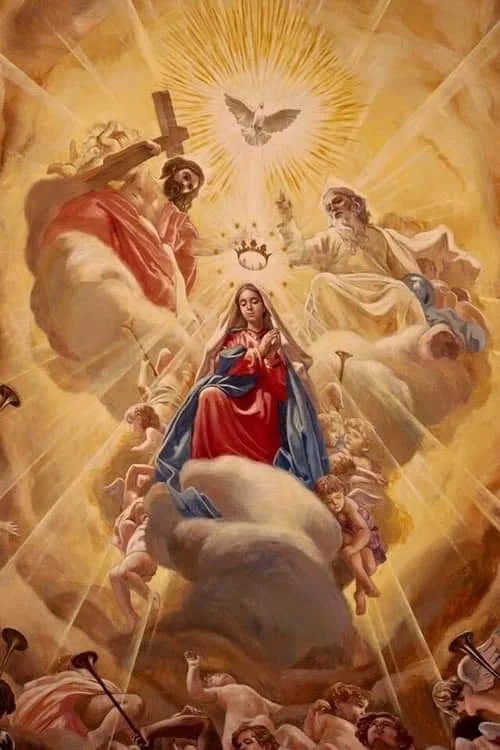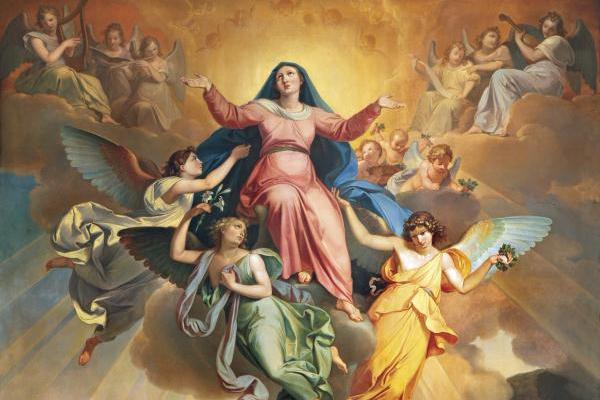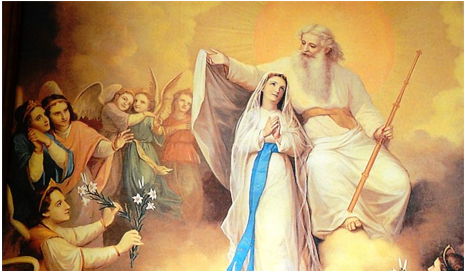THE ASSUMPTION OF THE VIRGIN MARY

POPE JOHN PAUL II GENERAL AUDIENCE
Wednesday, July 2, 1997
The Assumption of Mary, a truth of faith
1. In line with the Bull Munificentissimus Deus of my venerable Predecessor Pius XII, the Second Vatican Council affirms that the Immaculate Virgin, "having completed the course of her life on earth, was taken up body and soul into the glory of heaven" (Lumen Gentium, 59).
The Council Fathers wanted to reaffirm that Mary, unlike other Christians who die in God's grace, was raised to the glory of Paradise also with her body. This is an age-old belief, expressed also in a long iconographic tradition, which depicts Mary as she "enters" with her body into heaven.
The dogma of the Assumption affirms that Mary's body was glorified after her death. In fact, while for other men the resurrection of the body will take place at the end of the world, for Mary the glorification of her body was anticipated by a singular privilege.
2. On November 1, 1950, in defining the dogma of the Assumption, Pius XII did not want to use the term "resurrection" and to take a position on the question of the death of the Virgin as a truth of faith. The Bull Munificentissimus Deus limits itself to affirming the elevation of Mary's body to heavenly glory, declaring that truth "divinely revealed dogma".
How not to note here that the Assumption of the Virgin has always been part of the faith of the Christian people, who, by affirming Mary's entrance into heavenly glory, wanted to proclaim the glorification of her body?
The first testimony of faith in the Assumption of the Virgin appears in the apocryphal accounts entitled "Transitus Mariae", whose original nucleus dates back to the second and third centuries. They are popular representations, sometimes novelized, but in this case they reflect an intuition of faith of the people of God.
This was followed by a long reflection on Mary's destiny in the afterlife. This, little by little, led the believers to faith in the glorious elevation of the Mother of Jesus, in soul and body, and to the institution in the East of the liturgical feasts of the Dormition and the Assumption of Mary.
The faith in the glorious destiny of the soul and body of the Mother of the Lord, after her death, spread from the East to the West with great speed and, from the 14th century onwards, became widespread. In our century, on the eve of the definition of the dogma, it constituted a truth almost universally accepted and professed by the Christian community throughout the world.
3. Thus, in May 1946, with the encyclical Deiparae Virginis Mariae, Pius XII promoted a broad consultation, questioning the bishops and, through them, the priests and the people of God, on the possibility and timeliness of defining the bodily assumption of Mary as a dogma of faith. The response was largely positive: only six responses out of 1,181 expressed reservations about the revealed character of this truth.
Citing this fact, the Bull Munificentissimus Deus states: "The universal consent of the ordinary Magisterium of the Church provides a certain and solid argument to prove that the bodily assumption of the Blessed Virgin Mary into heaven (...) is a truth revealed by God and, therefore, must be firmly and faithfully believed by all the children of the Church" (AAS 42 [1950], 757).
The definition of dogma, in accord with the universal faith of the people of God, definitively excludes all doubt and demands the express adherence of all Christians.
After underlining the Church's present faith in the Assumption, the Bull recalls the scriptural basis of this truth. The New Testament, even without explicitly affirming the Assumption of Mary, offers its foundation, because it highlights the perfect union of the Blessed Virgin with the destiny of Jesus. This union, which is manifested already from the prodigious conception of the Savior, in the participation of the Mother in the mission of her Son and, above all, in her association with the redemptive sacrifice, cannot but demand a continuation after death. Mary, perfectly united to the life and salvific work of Jesus, shared his heavenly destiny in soul and body.
4. The above-mentioned Bull Munificentissimus Deus, referring to the participation of the woman of the Protoevangelium in the struggle against the serpent and recognizing in Mary the new Eve, presents the Assumption as a consequence of Mary's union with the redemptive work of Christ. In this regard he affirms: "Therefore, just as the glorious resurrection of Christ was an essential part and the ultimate trophy of this victory, so the struggle of the Blessed Virgin, common with her Son, was to conclude with the glorification of her virginal body" (AAS 42 [1950], 768).
The Assumption is, therefore, the point of arrival of the struggle that engaged Mary's generous love in the redemption of humanity and is the fruit of her unique participation in the victory of the cross.
Greetings
(To a group of Dutch pilgrims from the parish of Volendam)
Dear brothers and sisters, you have made your pilgrimage to thank the Lord for the restoration of your parish church. Continue to love your parish, because it is the privileged place where the faithful receive salvation through the proclamation of the Gospel and the celebration of the sacraments.
(In Croatian language)
Give new impetus to catechesis for children, youth and adults, because it educates in the faith and leads the baptized to the fullness of Christian existence in the time and environment where each one lives. This is a constant demand of the Church, which is even more evident today, in view of the preparation for the forthcoming Jubilee celebrations.
(To Czech pilgrims)
Saints Cyril and Methodius, apostles of the Slavs, whose feast will be celebrated in your homeland next Saturday, addressed your ancestors as teachers of the Gospel and educators of the generations for Christ. This is the most beautiful and greatest goal of all teachers.
(To the pilgrims from Slovenia)
The feast of the Apostles Peter and Paul has brought you to the eternal city to profess here your fidelity to Christ and his Church and thus to strengthen your Christian activity. May the heavenly Mother fill you with all the graces necessary for your daily activity.
(In Spanish)
I now wish to greet the Spanish-speaking individuals and groups present in St. Peter's Square; in particular, the Argentinean faithful of the Diocese of Rafaela and the young Chilean athletes, as well as the other pilgrims from Spain, Mexico, Bolivia, Argentina and Chile. Invoking the protection of Mary, so venerated in your countries under the title of Our Lady of the Assumption, I impart to you all my Apostolic Blessing.
(In Italian)
Dear young people, by your presence you bear witness to your faith in Christ Jesus who, together with your Pastors, calls you to build his Church, each according to his or her gift and responsibility. Respond generously to his invitation. Dear sick people, you too are here today to make an act of faith and ecclesial communion. The daily burden of your sufferings, if you offer it to Jesus Christ crucified, gives you the possibility of cooperating in your salvation and that of the world. Dear newlyweds, by your union you are called to be an expression of the love that unites Christ to his Church. Always be aware of the lofty mission to which the sacrament you have received commits you.


